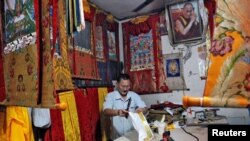Although Migmar Tsering crossed the border into India when he was just six-years-old, he remained closely connected to his Tibetan culture and language at the school for Tibetan refugees in the hill town of Mussoorie where he studied.
Now as principal of TCV Day School Samyeling in the Indian capital, 29-year-old Tsering, and his staff ensure that the more than 100 children of Tibetan refugees enrolled here imbibe Tibetan culture just as he did.
"They advise [the children] about Tibetan situation not related with political we have beautiful country, we have good language, we have a good identity, we have good religion," he said.
Led by teachers dressed in the Tibetan traditional dress, the chuba, young kids learn to write the script and chant nursery rhymes translated in Tibetan. And the noisy chatter as they run around and play is in their native language.
Amid fears that six decades of Chinese rule has resulted in Tibetan traditions being lost and its culture being assimilated into Chinese, the Tibetan spiritual leader, the Dalai Lama has frequently stressed the need to safeguard Tibetan culture. And as the Tibetan Exile Administration marks 60 years since the Dalai Lama fled to India, analysts say this goal has met with more success than the political struggle to gain autonomy for Tibet.
The heart of that effort is about 70 schools run by the Tibetan exile administration in India, which is home to the world's largest Tibetan refugee community. After the Dalai Lama fled to India following the 1959 failed uprising against Chinese rule, New Delhi allowed the setting up of separate Tibetan settlements and schools where a third generation of Tibetan refugees now study.
These schools emphasize learning in Tibetan until grade three. Teacher Sonam Choedon at the Tibetan school in the Indian capital points out that Beijing has sharply scaled back the teaching of languages spoken by ethnic minorities.
"In Tibet, now Tibetan language, Chinese they are suppressing, even in class they are not allowed to talk in Tibetan," she said. "So to preserve our language here in exile, especially in school, everything we try to convert in Tibetan only."
All subjects from science to math and environmental studies are taught in Tibetan in the junior classes. A reading room is not just stacked with books translated into Tibetan children sit on the floor to peruse the books placed on low desks in keeping with Tibetan tradition. In an adjoining room, young girls and boys play music on traditional Tibetan instruments.
"With the unparalleled support from India we have from the ashes of destruction revived Tibetan civilization, rebuilt Tibetan Buddhism, revived Tibetan culture, and preserved and promote Tibetan identity in India," Lobsang Sangay, prime minister of the Tibetan exile administration, said recently at a "Thank You India" event held to observe 60 years of the Dalai Lama's arrival in India.
The effort has made its mark. In Majnu-ka-Tilla, the Tibetan settlement where the New Delhi school is located, prayer flags are strung across a central square, maroon-robed monks light candles inside a Buddhist temple, old and young come to turn a prayer wheel and Tibetan food is commonly available. Nearby Tibetan handicrafts made by those who know the craft are sold.
However challenges lie ahead as a younger generation growing up in India gets restless and many look for opportunities overseas where Tibetans are more dispersed. The number of refugees coming to India has also slowed to a trickle.
Still hopes are high in the Tibetan exile community that those educated and brought up in India will carry the Tibetan influence and tradition with them outside.
Twenty-three-year-old Tenzin Dekong migrated to Australia in 2014 with her family. In India recently on holiday, she said she misses the Tibetan ambience in communities like Majnu-ka-Tilla. But the culture she assimilated as she grew up and studied in Dharamsala, the seat of the Tibetan government in exile, remains strongly with her.
"I am very sad that I can't see Tibet, but through the elder stories and through our teachers, when we learn Tibetan subjects we learn a lot of histories and I do really feel very connected with Tibetan cultures and I do have some imagination how Tibet looks like surrounded by all mountains, all the monastery," she said.
At his most recent appearance at the event to mark his 60 years in India, the Dalai Lama again stressed the importance of saving Tibetan culture. "We are not demanding separation from China but the Tibetan people should have the autonomy to preserve their culture, language, environment and religion," he said.
And many like principal Tsering, hope one day to carry the cultural roots they are so carefully nurturing in India to the homeland they fled or never saw. "We have truth, one day we go back to Tibet, I just believe that," he said.









